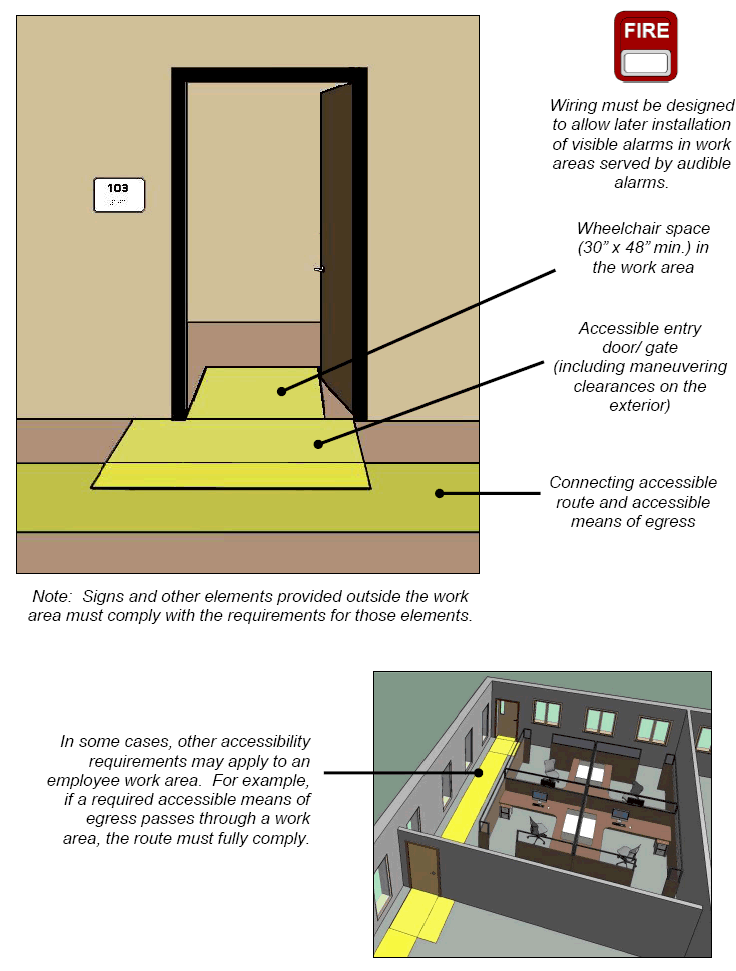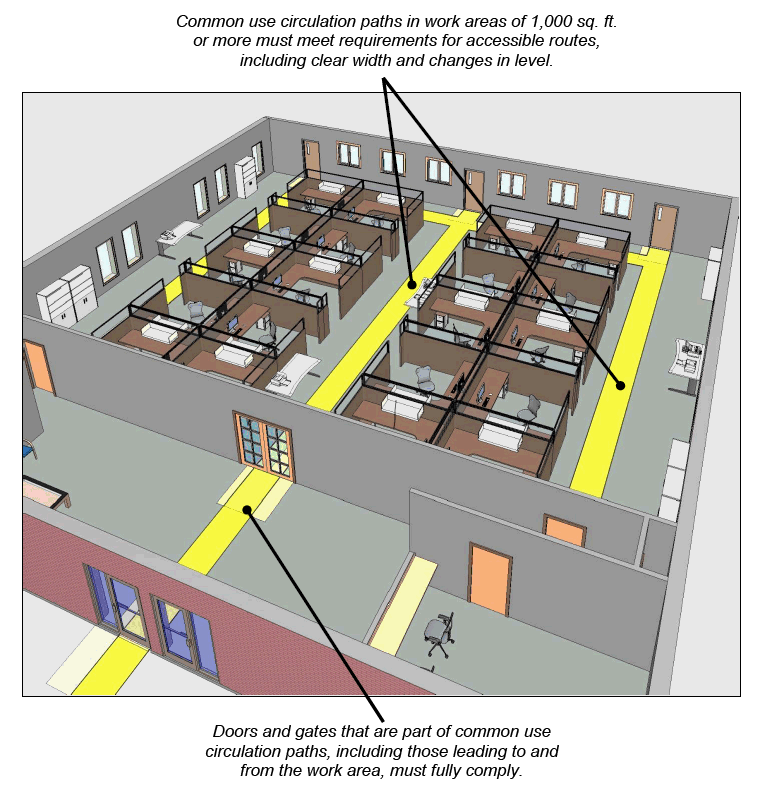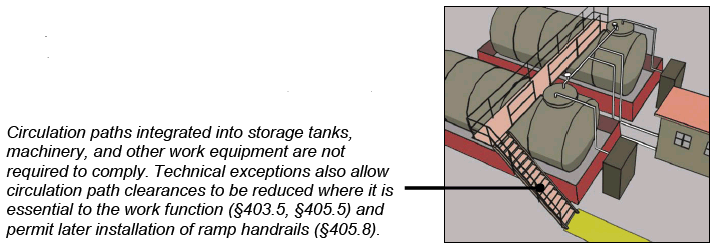General Exceptions [§203]
These structures and spaces are fully exempt from the standards and are not required to be accessible or on an accessible route:
Construction Sites (§203.2)
Structures directly associated with the actual processes of construction and portable toilets used only by construction workers
Examples: scaffolding, bridging, materials hoists, construction trailers
Areas Raised for Security/ Safety (§203.3)
Areas raised primarily for purposes of security or life/ fire safety
Examples: life guard stands, fire towers, and prison guard towers
Raised Work Areas (§203.9)
Employee work areas under 300 s.f. that are elevated at least 7” as an essential functional condition of the space (excluding raised courtroom stations)
Example: Work areas with equipment/ machinery that must be operated from a platform
Limited Access Spaces (§203.4)
Spaces accessed only by ladders, catwalks, crawl spaces, or very narrow passageways
Examples: lighting/ equipment catwalks at stages and performing areas, platforms served only by ladder
Machinery Spaces (§203.5)
Spaces used only by service personnel for maintenance, repair, or occasional monitoring of equipment
Examples: elevator pits/ penthouses, mechanical/ electrical/ communications equipment rooms, water or sewage treatment pump rooms, electric substations, and transformer vault
Single Occupant Structures (§203.6)
Single occupant structures accessed only by below-grade passageways or elevated above standard curb height
Examples: toll booths that are accessed by underground tunnels or elevated above curb height, such as those serving dedicated truck lanes
Detention/Correctional and Residential Facilities (§203.7 and §203.8)
Common use spaces in detention/ correctional facilities or residential facilities that do not serve accessible cells or dwelling units are exempt.
Certain Sports/ Recreation and Other Structures (§203.10 - §203.14)
These structures and spaces are also exempt:
-
raised structures used solely for refereeing, judging, or scoring a sport
-
raised boxing/ wrestling rings
-
water slides and raised diving boards/ platforms
-
animal containment areas not open to the public
Employee Work Areas [§203.9]
Title I of the ADA prohibits discrimination based on disability in the workplace. Information on the ADA and equal opportunities in hiring and employment, including reasonable accommodations for employees, is available from the Equal Employment Opportunity Commission at (800) 669‒4000 (v), (800) 669‒6820 (TTY), or www.eeoc.gov.
The ADA Standards require a more limited level of accessibility in employee work areas. At a minimum, areas used only by employees as work areas must meet requirements for:
-
access to approach, entry, and exit the work area (§203.9)
-
accessible means of egress (§207.1)
-
wiring for visible alarms in areas served by audible alarms (§215.3)
-
accessible common use circulation paths in most work areas of at least 1,000 sq.ft. (§206.2.8)
Other requirements, including those for turning space, do not apply to areas used only by employees for work.
These provisions apply to those areas where only work is performed by employees. Spaces not used for work, including employee restrooms, locker rooms, break rooms, cafeterias, and parking, must be fully accessible. Some public use spaces also function as work spaces, such as medical exam rooms and classrooms. These spaces must be fully accessible for public use, but elements within used only by employees for work are not required to comply.
Recommendation: Although areas used only by employees for work are not required to be fully accessible, consider designing such areas to include non-required turning spaces, and provide accessible elements whenever possible. Under the ADA, employees with disabilities are entitled to reasonable accommodations in the workplace. Accommodations can include alterations to spaces within the facility. Designing employee work areas to be more accessible at the outset will eliminate or reduce the need for more costly retrofits in providing reasonable accommodations for employees with disabilities.
Access to Approach, Enter, and Exit Work Areas
Access for “approach, entry, and exit” requires a connecting accessible route to the work area and a compliant entrance, including entry doors or gates, plus wheelchair space in the work area. Work areas must also be served by an accessible means of egress, as required by the International Building Code.
Access for Approach, Entry, and Exit
Common Use Circulation Paths in Employee Work Areas [§206.2.8]
Common use circulation paths must be accessible in work areas 1,000 square feet or more in size (as defined by permanently installed partitions, counters, casework, or furnishings). This requirement facilitates access to individual work stations within a space.
Common Use Circulation Paths
Work Area Circulation Paths: Exceptions
Common use circulation paths are required to be accessible except:
-
in work areas below 1,000 sq. ft. in size
-
in work areas fully exposed to the weather (regardless of size)
-
where they are integral to work equipment
Circulation Paths Serving Exempted Spaces [§203]
Portions of common use circulation paths serving exempt spaces within a work area are not required to comply, including routes to or within:
-
machinery spaces used only by service personnel;
-
spaces accessed only by ladders, catwalks, crawl spaces, or very narrow passageways;
-
employee work areas under 300 sq. ft. that are elevated at least 7” as an essential functional condition of the space (excluding raised courtroom stations);
-
and other exempted spaces.
Wiring for Visible Alarms [§215.3]
All employee work areas served by audible fire alarms, regardless of size, must be designed to support later installation of visible alarms after construction if needed. In new construction, alarm systems are typically provided with sufficient power resources to support the addition of strobes where they are needed to accommodate an employee who cannot hear the audible alarm.
Recommendation: In facilities where an above-average number of employees with hearing impairments is likely, such as in the offices of a school for people who are deaf or hard of hearing, it is advisable to equip alarm systems with power capacity above the level that is typically provided in order to accommodate a greater number of visual appliances.

















User Comments/Questions
Add Comment/Question